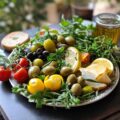Introduction to the DASH Diet
The DASH (Dietary Approaches to Stop Hypertension) diet is a heart-healthy eating plan designed to help treat or prevent high blood pressure. But it’s about so much more than just managing hypertension – it’s a compassionate approach to nourishing your body and promoting overall wellbeing. This 7-day DASH diet meal plan will guide you through a week of delicious, nutrient-rich meals that can help you feel your best.
The DASH diet emphasizes foods that are lower in sodium and rich in nutrients that help lower blood pressure, such as potassium, calcium, and magnesium. It includes plenty of fruits, vegetables, whole grains, lean proteins, and low-fat dairy. By focusing on whole, minimally processed foods, the DASH diet naturally aligns with principles of mindful and intuitive eating.
Benefits of Following the DASH Diet
Embracing the DASH diet can offer numerous benefits for your physical and emotional wellbeing:
- Lower blood pressure and reduced risk of heart disease
- Improved digestion and gut health
- Increased energy levels and mental clarity
- Better sleep quality
- Reduced inflammation in the body
- Potential weight loss or maintenance
- Greater connection to your food and eating habits
Remember, the goal of the DASH diet isn’t about restriction or deprivation. It’s about nourishing your body with wholesome foods that make you feel good, both physically and emotionally.
7-Day DASH Diet Meal Plan Overview
This 7-day meal plan is designed to give you a taste of what eating on the DASH diet can look like. Feel free to adjust portions or swap ingredients based on your personal preferences and needs. The most important thing is to listen to your body and eat in a way that feels good for you.
Here’s a brief overview of what each day might look like:
- Day 1: Oatmeal with berries, grilled chicken salad, baked salmon with roasted vegetables
- Day 2: Whole grain toast with avocado, lentil soup, turkey and vegetable stir-fry
- Day 3: Greek yogurt with nuts and fruit, tuna sandwich on whole grain bread, vegetarian chili
- Day 4: Scrambled eggs with spinach, quinoa and black bean bowl, grilled shrimp with brown rice and broccoli
- Day 5: Smoothie bowl, turkey and vegetable wrap, baked chicken with sweet potato and green beans
- Day 6: Whole grain pancakes with fruit, Mediterranean salad, lemon herb tilapia with quinoa and asparagus
- Day 7: Breakfast burrito with eggs and vegetables, vegetable soup with whole grain roll, tofu and vegetable curry with brown rice
Tips for Success on the DASH Diet
As you embark on your DASH diet journey, here are some compassionate tips to help you succeed:
- Practice mindful eating: Take time to savor your meals, eat slowly, and pay attention to your body’s hunger and fullness cues.
- Plan ahead: Prepare meals and snacks in advance to ensure you always have nourishing options available.
- Stay hydrated: Drink plenty of water throughout the day to support your body’s functions and help you feel your best.
- Be gentle with yourself: Remember that perfection isn’t the goal. If you deviate from the plan, simply return to it at your next meal without judgment.
- Experiment with herbs and spices: Use a variety of seasonings to add flavor to your meals without relying on salt.
- Include physical activity: Combine your healthy eating habits with regular, enjoyable physical activity for optimal wellbeing.
- Seek support: Share your journey with friends or family, or consider joining a support group for encouragement and motivation.
Incorporating DASH Diet Principles Long-Term
While this 7-day meal plan provides a great starting point, the true benefits of the DASH diet come from making it a sustainable part of your lifestyle. Here are some ways to incorporate DASH diet principles into your long-term eating habits:
- Gradually increase your intake of fruits and vegetables
- Choose whole grains over refined grains whenever possible
- Opt for lean proteins and plant-based protein sources
- Limit your intake of added sugars and saturated fats
- Read food labels to be aware of sodium content in packaged foods
- Cook more meals at home to have control over ingredients and portion sizes
- Practice moderation rather than complete restriction when it comes to treats
Remember, the DASH diet is not a quick fix or a temporary solution. It’s a compassionate approach to eating that can support your health and wellbeing for years to come.
Frequently Asked Questions
1. Can I follow the DASH diet if I’m vegetarian or vegan?
Absolutely! The DASH diet can easily be adapted for vegetarian or vegan lifestyles. Simply replace animal proteins with plant-based alternatives like beans, lentils, tofu, and tempeh. Ensure you’re getting enough vitamin B12, iron, and omega-3 fatty acids through fortified foods or supplements.
2. Will I lose weight on the DASH diet?
While weight loss isn’t the primary goal of the DASH diet, many people do experience weight loss as a side effect of eating more whole foods and fewer processed foods. However, it’s important to focus on how you feel rather than the number on the scale.
3. How long does it take to see results from the DASH diet?
Some people notice improvements in their blood pressure within a few weeks of starting the DASH diet. However, the most significant benefits come from long-term adherence to the diet. Remember, it’s about creating sustainable, healthy habits rather than achieving quick results.
4. Can I eat out while following the DASH diet?
Yes, you can still enjoy meals out while following the DASH diet. Look for menu items that include plenty of vegetables, lean proteins, and whole grains. Don’t be afraid to ask for modifications, such as dressings on the side or vegetables prepared without added salt.
5. Is the DASH diet suitable for everyone?
The DASH diet is generally considered safe and beneficial for most people. However, if you have any specific health concerns or dietary restrictions, it’s always best to consult with your healthcare provider before making significant changes to your eating habits.









